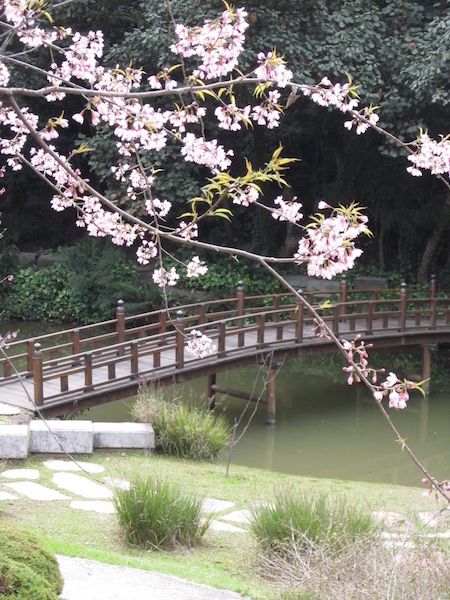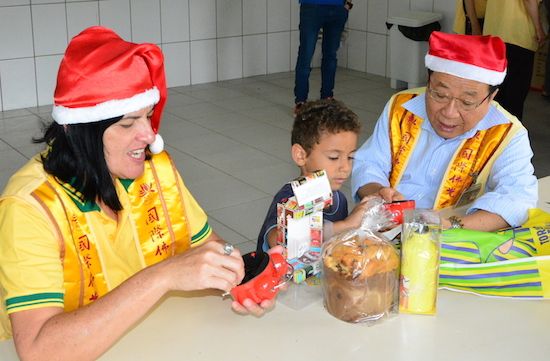FEATURES|VEHICLES|Mahayana
Zu Lai Temple: The Largest Buddhist Temple in South America
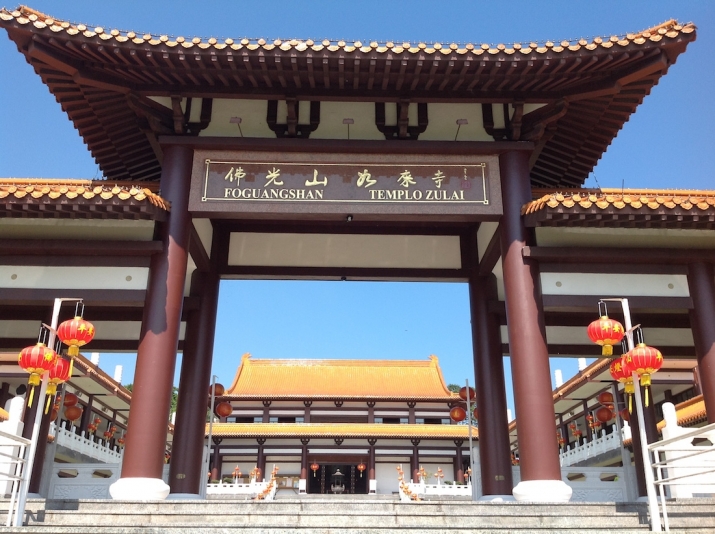 Zu Lai Temple entrance. Image courtesy of the author
Zu Lai Temple entrance. Image courtesy of the authorZu Lai Temple is the first branch temple of Fo Guang Shan Monastery (Buddha’s Light Mountain Monastery) in South America, and is acknowledged as the largest Buddhist temple on the continent. Situated in Cotia, a rural area of São Paulo in Brazil, the temple belongs to the Humanistic Buddhism movement founded in 1967 by the Chinese master Hsing Yun (b. 1927). This new movement is a blend of the eight traditional schools of Chinese Buddhism, among them Pure Land and Chan (Zen), and aims to foster peace and harmony throughout the world. Based in the city of Kaohsiung, the order is one of the largest charity organizations in Taiwan and has over 200 branches worldwide. Affiliated organizations are the Buddha’s Light International Association and the University of the West.
The temple in Brazil was established initially in April 1992, when Master Hsing Yun was invited to São Paulo to give a Dharma talk and for the inauguration of Templo Budista Kuan Yin. The talk so touched one member of the audience, the late Mr. Chang Sheng Kai, that he offered Master Hsing Yun his villa in Cotia, which became the first Fo Guang Shan temple in South America. Many people praised him for his generosity and said he was a 20th century Anathapindika, the wealthy layman who offered Jetavana Monastery to the historical Buddha, Shakyamuni. Master Hsing Yun then named the villa Zu Lai Temple, meaning “Temple of the Tathagata” (Tathagata is an epithet of the Buddha). Most of the nuns who had accompanied Master Hsing Yun to Brazil returned to Taiwan, leaving only the Venerable Jue Cheng (later well known as Mestra Sinceridade in Brazil), the temple’s first abbess and the current abbess of Fo Guang Shan Malaysia and Singapore. Based in Brazil from 1992 until 2006, Venerable Jue Cheng remains an important figure in the temple’s activities today. The Buddha’s Light International Association – Brazil Chapter was founded on the same occasion, with Mr. Shih Tze Lin elected president and Chang Sheng Kai, vice-president. Thus, there was no conscious decision to open a temple in Brazil—it occurred through auspicious “causes and conditions.”
As time passed, the villa-type temple was too small to accommodate the growing number of followers, who included Brazilians as well as residents of Taiwanese and Chinese descent. The generosity of these local devotees enabled the acquisition of the adjacent land, and the groundbreaking ceremony was held in the year 2000. After three years of construction, on 5 October 2003 a brand new Buddhist temple in the Chinese Tang dynasty (618–907) style was inaugurated, with an overall project area of 150,000 meters square and a constructed area of 10,000 meters square. Although Buddhism had reached China in the Han dynasty (206 BCE–220 CE) it was during the Tang that it became well known and widespread, and so the Tang style was selected for the temple in the hope that Buddhism would be just as well accepted in Brazil.
The temple consists of a main hall flanked by secondary buildings on either side, in the symmetrical arrangement characteristic of Chinese architecture. The multi-inclined roof features typical upturned flying eaves and glazed tiles specially imported from Taiwan, and is topped by a decorative ridge of tiles; it was installed by craftsmen brought over from Taiwan. The complex is situated in a large Zen garden, with a wooden bridge and a pond.
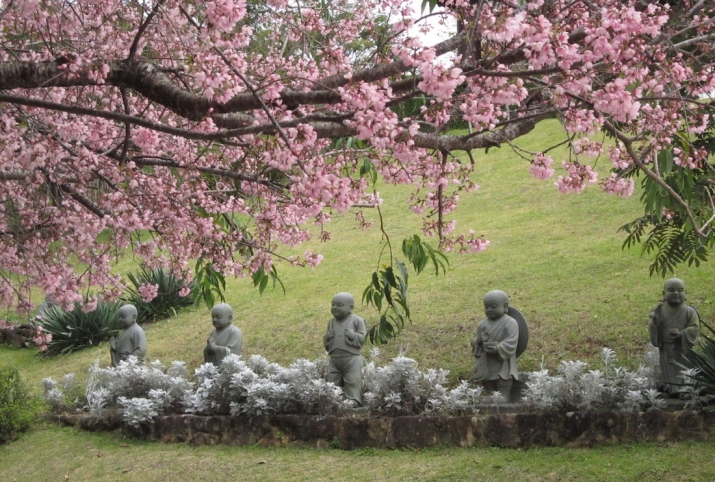 Statues in the Arhat Garden, Zu Lai Temple. Image courtesy of the author
Statues in the Arhat Garden, Zu Lai Temple. Image courtesy of the authorWhen they see the temple and its magnificent Chinese architecture for the first time, visitors are amazed. It offers a peaceful place for meditation and religious practice, and a great opportunity for spiritual improvement. The temple’s amenities and activities are all free of charge. The new temple has become known as the “Pure Land” of Humanistic Buddhism in South America and receives about 10,000 visitors a month, mainly from Brazil itself. Currently, there are six ordained monastics residing there, all of whom are nuns. The abbess Ven, Miao Yen and vice-abbess Ven. Jue Xuan are from Taiwan, while the rest of us are from Malaysia, Indonesia, and Brazil. Although we all have permanent resident status, every few years we are transferred to another Fo Guang Shan temple, elsewhere in the world.
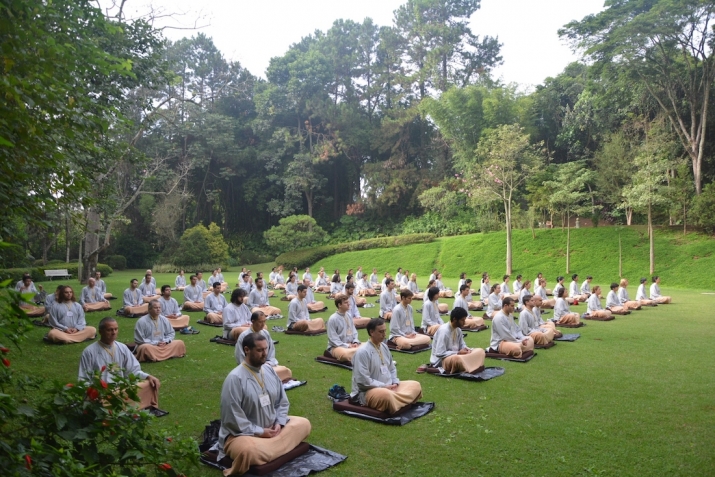 Meditation retreat, Zu Lai Temple. Image courtesy of the author
Meditation retreat, Zu Lai Temple. Image courtesy of the authorLike the other branch temples of Fo Guang Shan, Zu Lai Temple follows the four Main Objectives established by Master Hsing Yun:
To propagate Buddhist teachings through cultural activities
To foster talent through education
To benefit society through charitable programs
To purify human hearts and minds through Buddhist practice
To this end, we organize regular activities such as religious ceremonies and rituals, and hold celebrations on auspicious occasions like Chinese New Year, Vesak (Buddha’s birthday), and Sangha Day; we also offer courses in meditation, Chinese language, vegetarian cooking, Kung Fu, Tai Chi, and so on to the public on demand. In 2003, we established the “Sons of the Buddha” (Filhos de Buda) project to provide shelter and activities for children from the slums—they are often left to fend for themselves while their care-givers are at work, and it is important to keep them off the streets, where drug dealers abound. The project provides supplementary education for children aged 6 to 17, offering free courses like football, music, dancing, computer skills, and English. We teach the children ethics, Buddhist principles, and meditation, and provide scholarships for those who go on to university. Currently there are 150 students enrolled.
In 2004, the temple also established Zu Lai Buddhist Institute (Instituto Budista Zu Lai - IBZL) on the premises, giving those interested in Buddhism an opportunity to learn more. It offers a one-month internship program where students receive monastic training, follow a daily routine, and attend classes such as Buddhist history, introduction to Buddhism, sutra study, and meditation. Visiting homes for the elderly and orphanages are part of our activities as well—we sing and dance together, give them hugs, and bring them gifts and daily necessities. At the popular Brazilian cultural festival “Festa Junina” we hold a public event, issuing special invitations to residents of local old-age homes and orphanages, and to children from the cancer hospital and Sons of the Buddha. Normally, people drink alcohol and eat roast meat during the festival, but we have changed it to vegetarian food and non-alcoholic drinks. We have also adapted traditional festival games like “Escape from Prison” where, to get out of jail, “prisoners” have to memorize the Five Precepts and Three Acts of Kindness instead of paying a bribe! The temple’s activities have been well received by the community, as shown by the growing number of participants. This year, there were 3,000 people at Festa Junina (up from 1,000 in 2006), and 7,000 at Chinese New Year (up from 4,000 in 2006).
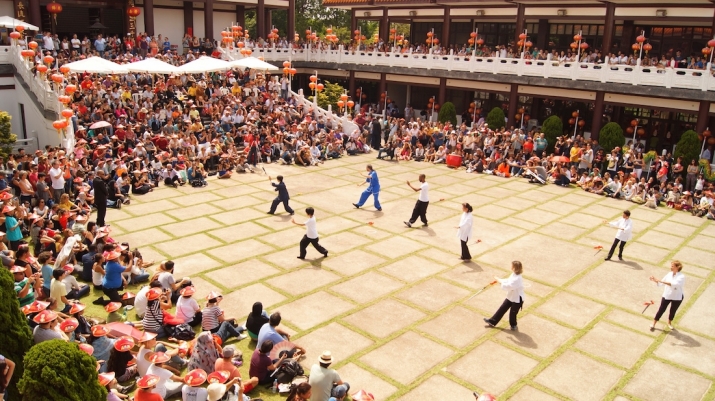 Chinese New Year celebration. Image courtesy of the author
Chinese New Year celebration. Image courtesy of the authorAccording to Master Hsing Yun, we do not need to seek enlightenment elsewhere but can actualize our true nature right now, in this very birth. He also believes that to transform our world, we must be actively engaged in it. “Community transcends the individual,” he says, “and in doing so, fulfills the individual in the most complete way possible.” In South America, Zu Lai Temple is playing its part to spread the Buddha’s Light.
Venerable Miao You currently resides at Zu Lai Temple. She is from Malaysia, and has lived in Brazil for more than nine years. She was ordained at Fo Guang Shan in Taiwan in January 2006.
See more
Fo Guang Shan Monastery
Templo Zu Lai (in Portuguese)

